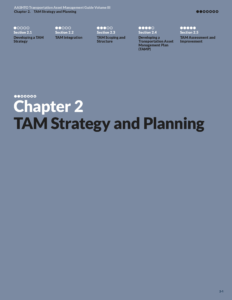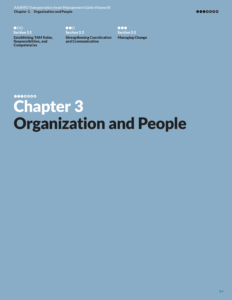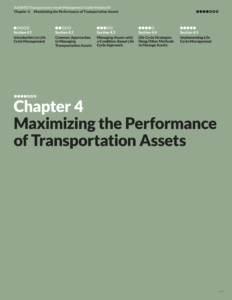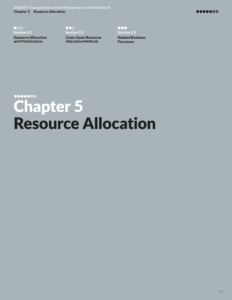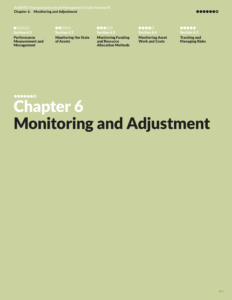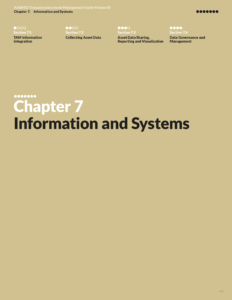AASHTO TAM Guide
The guide is organized into seven chapters. Each chapter is divided into sections that address fundamental aspects of TAM practice. Whether you are new to asset management, a seasoned practitioner, or an executive, this Guide will help to further your understanding of asset management techniques and advance asset management practices at your agency.
- Chapters
Chapter
Quick Links
Chapter 1
Introduction
This chapter introduces transportation asset management concepts and describes the organization of the guide.
What’s Important
Transportation Asset Management (TAM) is defined by the American Association of State Highway Transportation Officials (AASHTO) as a strategic and systematic process focused on business and engineering practices for allocating resources to assets throughout their lifecycles.
How the Guide Can Help
The purpose of this guide is to further transportation agencies’ understanding of asset management techniques and advance its practices. While the target audience for the guide is primarily State Departments of Transportation (DOTs), local agencies managing metropolitan, county, or mixed transportation networks will find it just as useful and appropriate to their needs.
Spotlight on
TAM Plans and Policies
The overall objective of asset management is better decision making in allocating resources based upon quality information and well defined objectives. The main benefits of asset management include:
- Improved asset condition performance, resilience, and longevity
- Increased efficiency and effectiveness
- More benefit for each dollar invested
- Improved accountability
- Reduced risk exposure
- Improved coordination and efficiency
Chapter 2
TAM Strategy and Planning
This chapter describes how to develop and implement a TAM strategy and Transportation Asset Management Plan.
What’s Important
A TAM strategy is the big-picture outlook needed to integrate asset management with existing business processes and make ongoing improvements once asset management is underway. The strategy establishes agency-specific asset management principles, connects to agency strategic goals, and provides a framework for how asset management will be carried out. A Transportation Asset Management Plan (TAMP) describes the long-term actions and costs to achieve the goals within the framework. Integrating TAM within existing strategic plans and processes is key to ensuring TAM is established and sustained.
How the Guide Can Help
The guide is designed to support a range of approaches to implementing asset management, from incremental improvements to across-the-board organizational change. No matter the approach, a fundamental step in asset management implementation is understanding the current strengths, weaknesses, achievable improvements and the areas where the most benefit can be gained. As described in the guide, this process involves:
- Assessing Current Practice
- Defining and Prioritizing Improvements
- Developing a TAM Implementation Plan
- Monitoring TAM Program Improvements
An integrated view of TAM is critical to its successful implementation. This chapter provides practical guidance on integrating TAM with other existing business processes and related disciplines including:
- Planning and Programming
- Performance Management
- Risk Management
- Data and Information Management
Spotlight on
TAM Plans and Policies
An asset management policy can be the first place an agency communicates the strategy of its asset management program. It helps formalize the scope, practices, and objectives of asset management. It can also serve as a commitment from the agency to stakeholders, establishing high priority initiatives and defining how TAM fits within the agency’s decision-making processes.
A Transportation Asset Management Plan (TAMP) describes an agency’s goals and objectives for maintaining its assets over time. It identifies the most critical assets and their current condition. The TAMP also describes the agency’s strategy for preserving its assets, predicting future conditions given the agency’s planned investments, formulating and delivering an investment plan, and how the agency manages risks to its assets.
Ideally a TAMP should both describe an agency’s assets and planned investments, and detail how it intends to improve its asset management approach. Where an agency has developed both a TAMP and an asset management implementation plan, the implementation plan can be incorporated as a section of the TAMP.
Chapter 3
Organization and People
This chapter provides practical guidance on the organizational factors that support successful TAM practice.
What’s Important
Asset Management is not possible without people within the organization who are committed to its success. This part of the asset management framework involves establishing TAM roles, responsibilities and competencies, strengthening coordination and communication, and managing change.
How the Guide Can Help
The guide introduces TAM organizational models and describes how these help determine how TAM is implemented throughout the agency. Because asset management is cross-cutting by nature, TAM requires coordinated actions across a diverse set of business units including planning, programming, scoping, design, construction, maintenance and operations functions. Various external entities also have a role in TAM and require coordination to deliver the best results. External stakeholders include customers using the transportation system, partners the agency works with such as toll authorities or operators of other modes of transportation, legislative and oversight bodies, and the general public. The guide describes how to employ coordination and communication strategies to bring people and groups together to achieve a common set of goals.
Spotlight on
TAM Plans and Policies
Strong communication helps ensure that new TAM initiatives are successful, effective and sustained. Successful communications help TAM implementation programs progress with momentum while maintaining awareness among all stakeholders. It is worthwhile to agree to and develop a communications plan so that everyone involved in TAM can help provide the most efficient and effective messaging. The plan can utilize a range of communication mechanisms including websites and webpages, workshops, public relations and events, PowerPoint presentations, and brochures and reports.
Chapter 4
Maximizing Asset Performance
This chapter introduces the concept of the asset life cycle, describes approaches to developing long-term management strategies, and provides guidance on how to execute these strategies on a day-to-day basis.
What’s Important
Life cycle management is a framework for identifying the appropriate treatments throughout an asset’s service life to maximize performance. All transportation infrastructure assets have a life cycle, which includes several stages from initial construction to removal or replacement. Maximizing transportation asset performance involves setting asset service and performance levels, and then identifying treatments to meet those levels over the full life-cycle of an asset at the least cost.
How the Guide Can Help
This chapter of the guide details a collaborative process for establishing a desired level of performance that considers:
- Current conditions and performance trends
- Available funding
- Expected demands on the system
- Policy goals and guidance
- Stakeholder priorities
Balancing the right treatment, at the right time, can greatly reduce the overall investment needed for infrastructure to reliably provide service. The guide describes the selection of a life cycle management approach that considers asset deterioration, performance, and risk over time.
For asset management goals to be met, tight coordination is needed between asset management and project development practices. The guide presents strategies for actively engaging maintenance management staff in the process of identifying preferred life cycle management approaches.
Spotlight on
TAM Plans and Policies
Asset condition is the most common performance criterion used by U.S. transportation agencies, particularly for pavements and bridges. The condition of an asset is measured and used to forecast and identify the onset of failure considering factors such as traffic demand, environmental and climatic conditions, and new technologies. Maintenance and preservation options are identified to address the failure mechanism and restore or extend service life. Options are compared over the long term to identify the set of treatments that will provide the best practical performance at lowest practical life-cycle costs. The condition-based management approach can be applied to simple and complex assets, groups of single assets or a whole network.
Some assets do not lend themselves to management using a traditional condition-based management approach for several reasons including a non-typical life-cycle (e.g. rock slopes), condition assessments are not feasible (e.g. buried utility assets), or end-of-life is driven by factors other than condition (e.g. technological obsolescence). These types of assets can often be managed using interval-based or reactive maintenance approaches.
Chapter 5
Resource Allocation
This chapter of the guide presents a general resource allocation process that can be applied to operations, maintenance, and renewal activities for a range of assets.
What’s Important
Organizations often lack the funding, staff, or other resources to achieve all their goals and objectives and need to make hard decisions about how to divide resources while considering competing needs. In the context of asset management, resource allocation is the process of assigning scarce resources such as funding, staff, and equipment to investments in transportation assets.
How the Guide Can Help
A systematic and repeatable resource allocation process helps an organization better determine how to best utilize any scarce resource, be it money, staff time, contractor capacity, equipment, or anything else that an organization requires for its assets. This guide describes an idealized allocation process to help illustrate key process steps and decisions an agency must make to improve its overall business process. It also addresses a range of issues and processes related to resource allocation, including:
- Consideration of Risk. Guidance for incorporating results of the risk management process described in Chapter 2 in resource allocation.
- Cross Asset Resource Allocation. Methods and guidance for maximizing performance and efficiency considering multiple asset types and investment objectives.
- Financial Planning. Development of a TAM financial plan and relationship of financial planning to resource allocation.
- Work Planning and Delivery . Alternative approaches for delivery of TAM maintenance activities and capital projects, implications of different delivery methods on resource allocation, and discussion of considerations in selecting the right delivery approach.
- Asset Valuation–Calculation and use of asset value as an important piece of financial reporting to communicate what an agency owns and maintains in order to support investment decisions.
Spotlight on
Cross-Asset Allocation
Prioritizing investments across asset classes and investment categories is an area of particular interest in TAM. However cross-asset resource allocation is complicated by several key challenges. These include reconciling competing objectives that cannot be easily compared, data limitations, and uncertainty concerning future conditions. Addressing these challenges requires adopting a performance-based approach that leverages an agency’s data.
One such performance-based approach is Multiple Objective Decision Analysis (MODA). To implement MODA an agency must systematically define its investment objectives, and determine how to quantify these through a set of performance measures. This information can then be used to calculate the overall utility and determine the relative priority of each candidate investment. The basic benefit of this approach is that it provides a structure for prioritizing investments outside the scope of any one management system, such as projects combining pavement, bridge and safety improvements. It also provides a means to compare asset management investments with other investments to improve mobility and achieve other objectives outside the scope of a typical asset management system.
Chapter 6
Monitoring and Adjustment
This chapter of the guide describes the information agencies must regularly monitor to ensure TAM continues to support business decisions.
What’s Important
TAM is a data-driven process that depends on the continued availability of reliable data to monitor asset and business performance measures and to make necessary adjustments to achieve agency objectives. A successful TAM program brings together information on asset condition, performance, and maintenance activities in conjunction with risk and financial data in order to understand performance, model trends, and drive TAM investment strategies.
How the Guide Can Help
This chapter’s focus on monitoring and adjustment is concerned with the ongoing effectiveness of an agency’s asset management program. The chapter provides practical guidance on what’s required to sustain a strong TAM program supported by data on:
- Transportation system performance and asset condition. For asset management decisions, asset inventory and condition information is most commonly used; however, other performance characteristics may also be used to monitor performance.
- Funding and resource allocation. Past funding and resource allocation trends provide valuable context for future investment strategies.
- Asset work and costs. In order to reliably assess current and future work needs over an asset’s life cycle, it is important to ensure completed maintenance and capital work activities are tracked and incorporated into the asset management programs.
- Risks. Risks are constantly changing and it is important to establish processes to track changes in risks over time and monitor actions taken to manage them.
- TAM processes. Regularly monitoring business processes helps ensure that analysis results continue to support investment decisions and that any gaps between desired and actual levels of maturity are addressed.
- Incorporating Maintenance Costs. Maintenance investments have a significant impact on asset conditions and should be accounted for in a TAMP. Maintenance costs commonly include labor, equipment, materials, and overhead expenses related to work performed by maintenance field crews, as well as the cost of contractor-delivered maintenance. This makes incorporating maintenance costs into a TAMP more challenging than incorporating the costs of other programs.
Spotlight on
TAM Plans and Policies
Performance measures and targets are key pieces of information used in asset management to allocate resources to assets throughout their life cycles. They are also used by agencies to provide feedback to internal and external stakeholders on the effectiveness of their activities. As a result, performance measures should be outcome based with a focus on the impact of activities that are important to the success of the program. They should indicate the effect on the traveling public resulting from the actions taken. Other desired characteristics of asset management performance measures include:
- Measurable with available tools to minimize additional cost of data collection;
- Collected at the appropriate level of detail to match the required detail to drive decisions;
- Forecastable to enable data-driven targets to be set based on future conditions;
- Clear to the public and lawmakers to allow performance story-telling to customers and policymakers;
- Influenced by agency activities rather than by external factors. Many organizations find that over time, the number of performance measures they are managing can become unwieldy. The number of performance measures should be reasonable focusing on the ones that support the right decisions.
Chapter 7
Information and Systems
This chapter of the guide describes how to determine TAMP data needs, the processes for ensuring it is accurate and current for asset decision-making, and systems for data management, analysis and reporting.
What’s Important
Deciding what data to collect and manage for asset management involves identifying information needs, estimating the full costs of obtaining and managing the data to meet those needs, and then determining whether the cost is justified. Once the desired data are identified, agencies must plan for the data collection process by coordinating with stakeholders, specifying exactly what data will be collected, and training staff to collect the data. As data are collected and checked through a quality assurance and control process, it becomes essential to have regular processes for updating the data. This can be accomplished through periodic data collection cycles, or through updating as part of asset project development and maintenance management processes.
How the Guide Can Help
Just as agencies do not have unlimited resources to repair and replace their assets, there are also limitations on resources for data collection and management. The guide presents the following questions to help identify asset management data needs:
- What decisions do we need to make?
- What questions do we need to answer that require asset data?
- What specific data items are required or desired?
- What value will each data item provide?
- What level of detail is required in the data?
- What level of accuracy is needed?
- How often should data be updated?
The Guide describes how integrating information across different systems can enable agencies to maintain an asset inventory in a single source system of record and share it with other systems. Integrating data for TAM should be approached systematically to ensure agencies achieve a solution that meets their needs and is ultimately sustainable. In the short term, agencies can integrate the information they already have. In the longer term, agencies can modify and consolidate their information systems.
Spotlight on
TAM Plans and Policies
Data governance and management practices are essential to achieve reliable, consistent, integrated and accessible data that is of value for decision-making. Data management includes activities such as data quality management, documentation, metadata management, security and access controls, data integration, and archiving. Data governance, is a policy making and oversight function for data management. Implementing data governance involves forming and chartering decision making bodies, defining roles and responsibilities, establishing policies that set expectations for behavior, and setting up standard processes for things like approving data standards, resolving data issues, and acquiring new types of data. Data stewardship refers to established responsibilities and accountabilities for managing data. Data stewardship can be viewed as the way to operationalize data governance policies, processes and standards.
Data governance is generally implemented in a hierarchical fashion, with an executive body at the top, a data council or board in the middle, and several more focused groups oriented around specific systems, business processes, organizational units or functions. It is best to take an incremental approach to start, beginning with a few high impact areas that are aligned with what the agency is trying to achieve.

